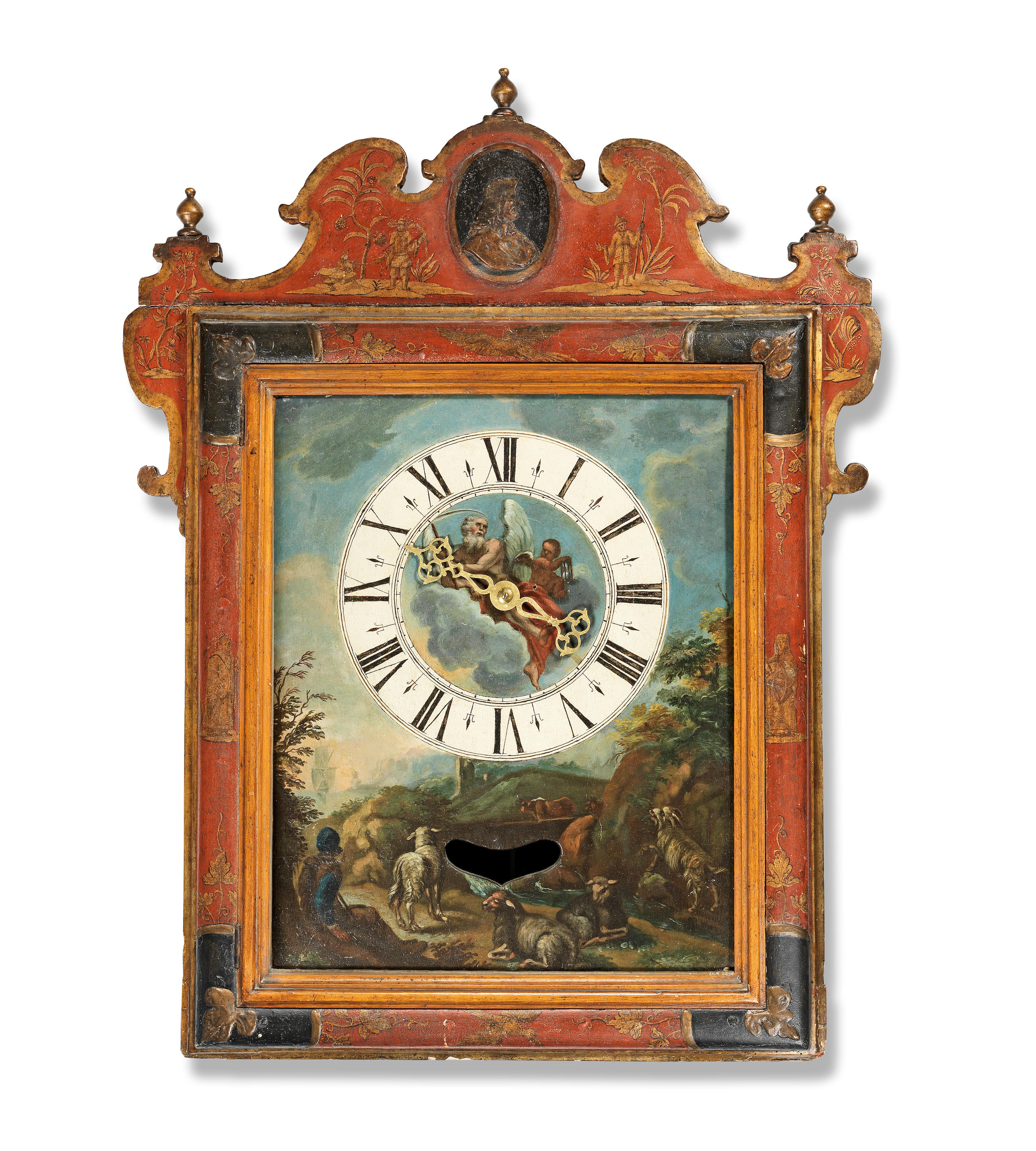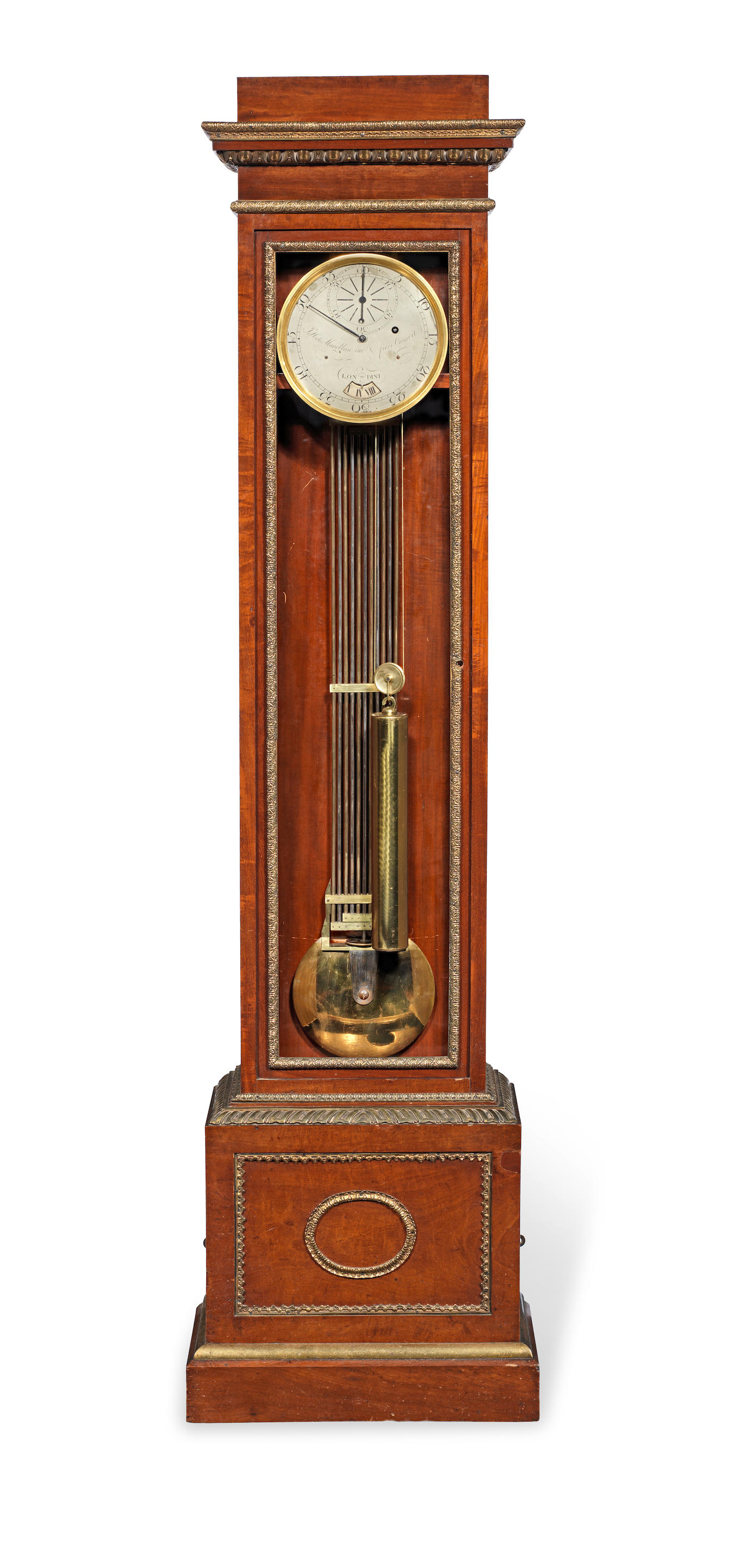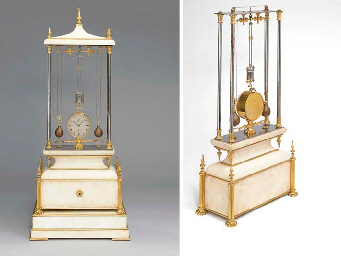A rare weight driven small 'diamond' dial wall timepiece movement with alarm Unsigned but with similarities to the work of the Knibb family, late 17th century The four distinctive baluster pillar turned movement with slender plates measuring 7 by 2.75 inches enclosing three wheel train incorporating verge escapement regulated by short bob pendulum, the frontplate with the top corners cut to follow the profile of the dial and the right hand side applied with a transverse alarm mechanism sounding on a small bell mounted above the plates, the 6 inch square brass dial orientated 45 degrees to form a diamond and with starburst engraved alarm setting disc to the matted centre within applied silvered Roman numeral chapter ring with unusual pendant half hour markers, with pierced steel hand and winged cherub mask spandrels to angles. Diamond dial wall timepieces are an unusual and rare variant which appeared to gain some popularity during the latter quarter of the 17th century as an alternative to lantern or hooded alarum timepieces. Such timepieces are discussed by Bill Linnard in his three articles entitled Diamonds are Forever?, More Diamond Dials and Diamonds Galore published in the May 2005, April 2006 and April 2007 issues of the Horological Journal respectively. Linnard surveys thirteen other examples which he dates between circa 1670 and 1740. The earliest example he describes is a thirty-hour single-handed spring driven timepiece by John Wise of London which he dates to around 1670, with the next being the circa 1680 weight-driven alarm timepiece by Joseph Knibb illustrated in Dawson, Percy G., Drover, C.B. and Parkes, D.W. Early English Clocks on page 530 (plates 781-3). Other examples by Leading London makers such as Tompion (now cased as a table clock) and Samuel Watson are also discussed. More recently diamond dial wall timepieces have featured in articles published in Antiquarian Horology by Jonathan Betts (Showtime at Oxnead: The timekeepers depicted in 'The Paston Treasure; Vol XXXIX June 2018, pages 215-24) and Martyn Pettifer (Another Diamond; Vol IVI June 2020, pages 209-13). It would appear that the vast majority of diamond dial wall timepieces were constructed with one of the movement plates formed with the top and bottom sections angled by ninety degrees to create integral top and bottom plates to which the other plate is joined by pinned tenons. This type of 'box frame' construction can be seen on an example by John Knibb, Oxford (ex Shapiro collection) sold in these rooms on Tuesday 11th March 2014 (lot 144) as well as the timepiece discussed by Martyn Pettifer in his article. The construction of the current lot however is more akin to that of traditional longcase or table clocks with plates united by separate turned pillars, hence can be compared to the relatively early example by Joseph Knibb illustrated in Early English Clocks on page 530 (plates 781-3). In addition to the general basic layout of the movements both the current lot and the example signed by Joseph Knibb have related baluster-shaped pillars; with the castings seen on the present example being of the pattern often seen on table clocks by both the brothers John and Joseph Knibb In addition to the presence of the distinctive pillar castings the wheelwork of the present movement is also notably fine incorporating concentric line detailing to the rims and a greatwheel of 96 teeth. The movement plates are also reasonably thin/delicate which when considered alongside these other factors would support the idea that the mechanism was perhaps made in the workshops of either John or Joseph Knibb and then supplied to another maker for finishing.
A rare weight driven small 'diamond' dial wall timepiece movement with alarm Unsigned but with similarities to the work of the Knibb family, late 17th century The four distinctive baluster pillar turned movement with slender plates measuring 7 by 2.75 inches enclosing three wheel train incorporating verge escapement regulated by short bob pendulum, the frontplate with the top corners cut to follow the profile of the dial and the right hand side applied with a transverse alarm mechanism sounding on a small bell mounted above the plates, the 6 inch square brass dial orientated 45 degrees to form a diamond and with starburst engraved alarm setting disc to the matted centre within applied silvered Roman numeral chapter ring with unusual pendant half hour markers, with pierced steel hand and winged cherub mask spandrels to angles. Diamond dial wall timepieces are an unusual and rare variant which appeared to gain some popularity during the latter quarter of the 17th century as an alternative to lantern or hooded alarum timepieces. Such timepieces are discussed by Bill Linnard in his three articles entitled Diamonds are Forever?, More Diamond Dials and Diamonds Galore published in the May 2005, April 2006 and April 2007 issues of the Horological Journal respectively. Linnard surveys thirteen other examples which he dates between circa 1670 and 1740. The earliest example he describes is a thirty-hour single-handed spring driven timepiece by John Wise of London which he dates to around 1670, with the next being the circa 1680 weight-driven alarm timepiece by Joseph Knibb illustrated in Dawson, Percy G., Drover, C.B. and Parkes, D.W. Early English Clocks on page 530 (plates 781-3). Other examples by Leading London makers such as Tompion (now cased as a table clock) and Samuel Watson are also discussed. More recently diamond dial wall timepieces have featured in articles published in Antiquarian Horology by Jonathan Betts (Showtime at Oxnead: The timekeepers depicted in 'The Paston Treasure; Vol XXXIX June 2018, pages 215-24) and Martyn Pettifer (Another Diamond; Vol IVI June 2020, pages 209-13). It would appear that the vast majority of diamond dial wall timepieces were constructed with one of the movement plates formed with the top and bottom sections angled by ninety degrees to create integral top and bottom plates to which the other plate is joined by pinned tenons. This type of 'box frame' construction can be seen on an example by John Knibb, Oxford (ex Shapiro collection) sold in these rooms on Tuesday 11th March 2014 (lot 144) as well as the timepiece discussed by Martyn Pettifer in his article. The construction of the current lot however is more akin to that of traditional longcase or table clocks with plates united by separate turned pillars, hence can be compared to the relatively early example by Joseph Knibb illustrated in Early English Clocks on page 530 (plates 781-3). In addition to the general basic layout of the movements both the current lot and the example signed by Joseph Knibb have related baluster-shaped pillars; with the castings seen on the present example being of the pattern often seen on table clocks by both the brothers John and Joseph Knibb In addition to the presence of the distinctive pillar castings the wheelwork of the present movement is also notably fine incorporating concentric line detailing to the rims and a greatwheel of 96 teeth. The movement plates are also reasonably thin/delicate which when considered alongside these other factors would support the idea that the mechanism was perhaps made in the workshops of either John or Joseph Knibb and then supplied to another maker for finishing.















Testen Sie LotSearch und seine Premium-Features 7 Tage - ohne Kosten!
Lassen Sie sich automatisch über neue Objekte in kommenden Auktionen benachrichtigen.
Suchauftrag anlegen